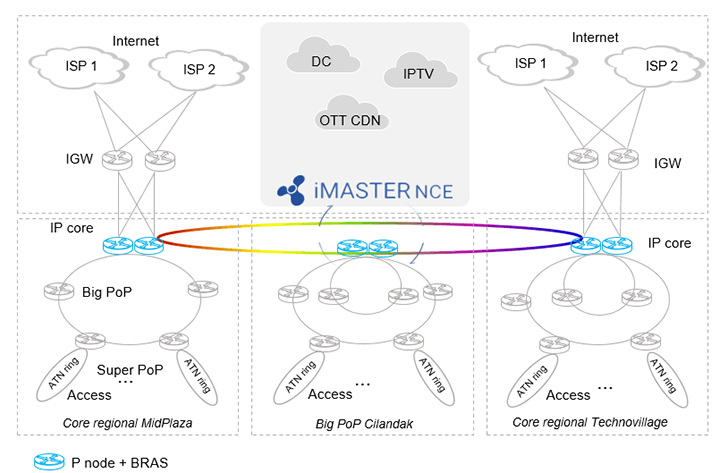Indonesia Biznet: Building a Future-Oriented Intelligent MAN
Este sitio utiliza cookies. Si continúa navegando en este sitio, acepta nuestro uso de cookies. Lea nuestra política de privacidad>
![]()
Productos, soluciones y servicios empresariales
As new services — such as remote office and online shopping — continue to emerge, more and more activities are being performed online, further increasing the requirements for high-quality service experience. Biznet is an ISP that has the highest FTTH network quality in Indonesia, but due to insufficient coverage of its optical fiber resources, it faced issues such as low bandwidth and difficult service experience assurance.
To address those issues, reducing backbone network bandwidth consumption and improving fiber utilization, Biznet decided to build a future-oriented intelligent MAN featuring a flat architecture, and turned to Huawei for help. This new network lays a solid and reliable digital infrastructure foundation for Indonesia, paving the way for its future service development.
Biznet provides a wide range of Internet services and has maintained fast and steady growth — in terms of both services and network scale — since its establishment in 2000. By 2023, Biznet has built 92,000 km of its own optical fiber network and gained 2.3 million Homepass subscribers, with its network covering more than 180 cities in Indonesia.
According to Fiber Route Plan 2022-2026, Biznet will continue to build its fiber network to connect all the areas in which it operates. Biznet is committed to investing and innovating in the latest technologies to provide better services and wider network coverage.
With the rapid development of smart terminals and emerging applications, HBB services demand higher-quality experience, cloud-based enterprise applications require higher-quality private lines, and HD videos demand higher bandwidth. The changes in service scope and user requirements bring significant risks and challenges to Biznet's network — for example, insufficient bandwidth, low reliability, poor user experience, and difficult O&M.
Insufficient bandwidth: Emerging services such as cloud computing, e-commerce, and HD video lead to exponential growth of bandwidth demand in Indonesia. Biznet's live network, which utilized old technologies and architectures, was far from meeting the bandwidth demand.
Low reliability: There was no redundancy protection for service paths. A single BRAS is incapable of backing up user information and therefore cannot provide quality guarantee for user connections.
Poor user experience: BRASs were unevenly distributed. In some cities, cross-backbone-network authentication was limited by bandwidth and latency. Furthermore, single BRASs with limited performance led to poor user experience and numerous complaints.
Difficult O&M: E2E services needed to be manually configured and adjusted, and service provisioning took a long time. On top of that, it was nearly impossible to quickly locate and rectify network faults, resulting in high O&M costs and low efficiency.
Solution:

With industry-leading NetEngine 8000 F1A mini-BNGs and the converged IP MAN solution provided by Huawei, Biznet successfully built a future-oriented intelligent MAN and a secure and reliable 100 Gbps ultra-broadband backbone network to provide ultimate bandwidth experience in Indonesia.
High bandwidth: Huawei's flagship routers support 1T line cards, which can smoothly evolve to 2T. These routers can be used to build 100G/200G fiber backbone networks.
High reliability: The IP core network adopts dual-device hot backup for BRASs and dual Internet egresses. It uses VRRP + BFD for fast fault detection (within 3.3 ms) and FRR for fast service switching (within 50 ms).
Low latency: Distributed BRASs are deployed closer to users, minimizing service latency.
Easy O&M: iMaster NCE-IP provides unified management and O&M for network-wide devices.
In the future, Biznet will work with Huawei to build an evolvable, stable, and reliable IPv6 + ISP 2.0 target network. Comprehensive upgrade of the IPv6-based next-generation Internet gives rise to innovative technologies such as SRv6, IFIT, and network slicing, significantly improving IP network capabilities.
SRv6 simplifies control protocols and enables network automation. SRv6 can be deployed on the ingress and egress nodes to quickly deploy private lines for one-hop cloud access and service provisioning within minutes.
IFIT, which supports both E2E and hop-by-hop measurement, provides a higher-precision service-level SLA measurement scheme. In E2E mode, IFIT only needs to be deployed on the ingress and egress nodes for KPI measurement. IFIT can detect service faults in real time, restore real service paths, locate faults within minutes, and trigger path adjustment based on nodes with abnormal packet loss or delay to quickly restore services.
Network slicing provides high-quality private line services. Huawei's industry-unique 10GE FlexE-capable CPEs provide hierarchical fine-grained slicing and elastic slice adjustment within minutes, ensuring hard pipe isolation for key services and on-demand bandwidth allocation.
Mini-BNG High-End Router:
Huawei's NetEngine 8000 F1A is an edge access router designed for all scenarios, featuring high-density 100G ports. It is deployed as the metro access/aggregation node on Biznet's network to meet increasing service requirements.

The NetEngine 8000 F1A is the industry's highest-density fixed-configuration router, boasting a forwarding capacity of 1.2 Tbps and supporting flexible combinations of up to 56 ports. Despite its impressive capabilities, it measures only 420 mm deep and 1 U high, saving valuable equipment room resources while reducing CAPEX. Moreover, its ultra-low power consumption (0.3 W/G) and environment-friendly design make it an energy-efficient option. With leading SRv6 capabilities, NP programmable architecture, and the ability to smoothly evolve over the next 10 years, it is an ideal choice for Biznet to quickly extend HBB network coverage and rapidly develop HBB subscribers.
Solution Benefits:
With Huawei's help, Biznet has built future-oriented intelligent networks with continuous IPv6 technology innovations.
• High reliability design at device, protocol, and chip levels help ensure service continuity.
• The adoption of a flat MAN architecture and distributed BRASs with built-in PE, P, and CGN capabilities lowers space requirements for equipment rooms and network construction costs. Moreover, distributed BRASs are deployed at the metro edge, reducing bandwidth consumption on the backbone network and improving user experience.
• Network-wide visualized O&M, including fault, experience, and network quality visualization, enables E2E efficient O&M.